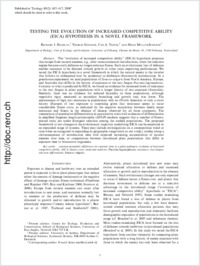Testing the Evolution of Increased Competitive Ability (EICA) hypothesis in a novel framework
- Handley, Richard J. Department of Biology, Unit of Ecology and Evolution, University of Fribourg, Switzerland - Centre for Ecology, Evolution and Conservation, School of Biological Sciences, University of East Anglia, Norwich UK
- Steinger, Thomas Department of Biology, Unit of Ecology and Evolution, University of Fribourg, Switzerland
- Treier, Urs A. Department of Biology, Unit of Ecology and Evolution, University of Fribourg, Switzerland - University of Aarhus, Department of Biological Sciences, Systematic Botany, Denmark
- Müller-Schärer, Heinz Department of Biology, Unit of Ecology and Evolution, University of Fribourg, Switzerland
-
2008
Published in:
- Ecology. - 2008, vol. 89, no. 2, p. 407–417
Common groundsel
Differences in exposure time to a plant pathogen
Evolution of increased competitive ability
EICA
Fitness costs
Molecular markers
Puccinia lagenophorae
Resistance
Rust fungus
Selection differentials
Senecio vulgaris
English
The “evolution of increased competitive ability” (EICA) hypothesis proposes that escape from natural enemies, e.g., after transcontinental introductions, alters the selection regime because costly defenses no longer enhance fitness. Such an evolutionary loss of defenses enables resources to be directed toward growth or other traits improving performance. We tested the EICA hypothesis in a novel framework in which the natural enemy is the traveler that follows its widespread host by accidental or deliberate (biocontrol) introductions. In a greenhouse experiment we used populations of Senecio vulgaris from North America, Europe, and Australia that differ in the history of exposure to the rust fungus Puccinia lagenophorae. Contrary to what is predicted by EICA, we found no evidence for increased levels of resistance to the rust fungus in plant populations with a longer history of rust exposure (Australia). Similarly, there was no evidence for reduced fecundity in these populations, although vegetative vigor, measured as secondary branching and growth rate, was lower. The maintenance of high rust resistance in populations with no (North America) or only a short history (Europe) of rust exposure is surprising given that resistance seems to incur considerable fitness costs, as indicated by the negative association between family mean resistance and fitness in the absence of disease observed for all three continents. The comparison of population differentiation in quantitative traits with estimates of differentiation in amplified fragment length polymorphic (AFLP) markers suggests that a number of fitness-related traits are under divergent selection among the studied populations. The proposed framework to test changes in the evolutionary trajectory underlying EICA can be employed in an expanded range of systems. These may include investigations on a cosmopolitan weed or crop when an antagonist is expanding its geographic range (such as our study), studies along a chronosequence of introduction time with expected increasing accumulation of natural enemies over time, or comparisons between introduced plant populations that differ in exposure time to biocontrol organisms.
- Faculty
- Faculté des sciences et de médecine
- Department
- Département de Biologie
- Language
-
- English
- Classification
- Biological sciences
- License
- License undefined
- Identifiers
-
- RERO DOC 9204
- DOI 10.1890/07-0160.1
- Persistent URL
- https://folia.unifr.ch/unifr/documents/300645
Statistics
Document views: 160
File downloads:
- muellerschaerer_tei.pdf: 170
